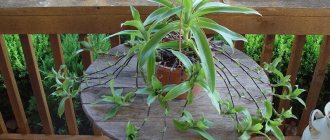Ficus Tineke is a variety that, thanks to breeders, can delight the gardener’s eye with its beauty for many years and even decades. The presented variety belongs to the type of rubber-bearing ficus (elastica). In Indonesia and India (in their homeland), these cacti reach a height of 30 meters.
Of course, it is impossible to achieve such records at home. The plant does not take root; it has only one trunk, which does not grow higher than two meters. It is interesting that in the initial stages the ficus grows quite quickly; in just six months or a year it can add as much as 50 cm.
Many gardeners purchase Tineke not only for its unusual appearance, but also because the plant is considered a symbol of family happiness and longevity, and also fills the house with positive energy.
Description and characteristics of ficus Tineke Elastica
Tineke is one of the varieties of the Ficus rubber (Elastic) species. In its natural habitat, the Indian and Indonesian tropics, it is cultivated to obtain natural rubber from the milky sap of the plant. In the open air it can reach a height of 30-40 meters. In indoor conditions, its growth is controlled by pinching, pruning and limiting the size of the pot. As a result, the ficus grows up to one and a half to two meters in height, and produces a lush crown.
The main advantage of the plant, beautiful decorative leaves:
- size - 25 cm in length and 15 in width;
- shape - oval with a pointed tip;
- color - green with a pronounced central vein.
On the sides, the leaf plates are decorated with an openwork, light edge, white, cream or light green. Thanks to it, the plant looks very picturesque.
Interesting. It’s not just decorativeness that has made Tineke a popular apartment dweller. The phytoncides it produces kill up to 40% of bacteria in the air. Leaves absorb toxic compounds: formaldehyde and phenol.
How does crown formation occur and when?
If you want the ficus to have a decorative appearance, you can braid an original braid or something similar from several trunks. To do this, you need to plant several young plants in one pot and braid the trunks as the ficus grows.
As for the formation of the crown, first of all, all dried and unnecessary branches are cut off, which do not allow light to penetrate deep into the plant.
If I want to create splendor, I cut off the top shoots so that the green mass grows on the sides. Otherwise, it is the side branches that are pruned.
The manipulation is carried out at the end of winter - beginning of spring, before active sap flow begins.
To grow ficus elastica, you need to work a little, but the result is worth it.
What to look for when choosing a plant?
In order for the ficus to take root in the house, you need to buy a healthy plant. Signs of disease are:
- spots or spots on leaves;
- insects on the stems or damage to the leaf blade (corroded edges, holes);
- black or dark brown roots visible through drainage holes.
On a note. Before purchasing, shake the plant directly with the pot or lightly run your hand over it; if the leaves fall off, it is better to choose another specimen.
You should buy ficus trees in spring or summer. This will make it easier and faster for him to adapt to his new home. It is better to give the choice to a young plant. It will be easier for him to adapt to new conditions. After purchasing, be sure to wash the leaves. Some sellers rub them with polish to make the plant look more attractive, but this negatively affects the health of the ficus.
Photo
All ficus belong to a large group of decorative foliage plants. Among them you can find many very interesting specimens. We would like to present to your attention articles about False Palms and Orchids.
Growing conditions
Ficus Tineke is unpretentious. The plant can survive: long-term lack of watering, insufficient lighting and nutrition.
However, with poor care, it will lose its decorative effect:
- growth will slow down;
- the crown will look scanty;
- the leaves are crushed and become monochromatic.
To avoid this, you should pay attention to Tineka, then the appearance of the ficus will delight others.
Temperature and humidity
Tineke come from the tropics, so they love warmth - 18-25 degrees. However, in winter you don’t have to be afraid of “catching” the plant, because:
- young ficus trees will easily survive a long cold snap down to +15-16;
- adult specimens are able to overwinter at temperatures of 5-7 degrees and even survive short-term frosts.
- in summer Tineke can withstand +30-40 degrees. However, if the temperature rises above +24, the plant must be sprayed twice a day.
Temperature changes can cause leaves to fall. However, the plant itself will survive the winter only if the roots remain warm. Therefore, a ficus pot cannot be placed on window sills or a cold floor. Teenekes do not take well to drafts, at any time of the year.
Indoor humidity should remain high regardless of the season. In winter, place a humidifier or a container of water in the room. If the house is warm enough (+18 and above), you can spray the plant to provide it with sufficient moisture.
Soil and soil
Ficus Tineke can be planted in ordinary universal soil, adding a little sand and peat to ensure looseness of the soil. You can also make your own substrate. To do this, mix in equal parts: garden humus, crushed peat, coarse sand.
Soil acidity should be slightly acidic or neutral. It can be measured with litmus strips. For this:
- A little soil is wrapped in thick cloth.
- Place in a glass with distilled or rain water (in proportions with the soil mixture 1:1);
- Leave for five minutes.
- Take out the package with soil;
- Quickly dip the litmus strip into water or squeeze one drop from a pipette onto it.
- Check the color with the indicator scale (if it’s orange or red, it’s acidic; if it turns blue, it’s alkaline).
You can reduce acidity using dolomite flour, chalk, ash (a few grams per pot). Increase - with peat, a weak solution of vinegar, citric or any other acid (a couple of drops). It is better to use peat, as there is less chance of acidifying the soil.
Lighting
Tineke is a light-loving plant, but on summer days direct sunlight can cause burns on the leaves. Young specimens are especially sensitive to bright light. Therefore, the optimal place for a ficus is the floor next to the window sill or even in the back of the room. On too hot days, the window can be shaded with a lowered curtain.
If there is a lack of light, the plant will live and even develop, but will lose its decorative effect:
- the lower leaves will turn yellow and fall off;
- the light edge will turn green;
- the stem and branches will begin to stretch.
When these symptoms appear, the plant should be moved closer to the window and additional lighting should be provided.
Important. In order for the crown to develop evenly (the branches do not stretch in one direction), the pot with the plant must be turned one or two centimeters every 7-10 days.
Watering
The frequency of watering depends on the time of year and the established temperature conditions. In summer it is allowed to water the flower twice a week, in winter - once.
One of the important rules for growing rubber ficus at home is moderate watering. Flooding is unacceptable - this can cause the tree to shed its leaves. It is better to use soft, settled water.
Caring for a flower at home
Ficus trees do not require special care. Like other indoor plants, they need:
- periodic fertilization
- regular watering;
- replanting as it grows;
- treatment when diseases appear.
If you follow the rules of care, ficus grows quickly. Young specimens develop one leaf every 7-10 days.
Feeding and fertilizer
The main nutrients for plants are: nitrogen, potassium, phosphorus. The percentage composition of the components is indicated on each fertilizer package. Choose one that contains a large amount of nitrogen. It should be twice as much as potassium or phosphorus. Nitrogen is necessary for the development of green mass (side shoots and leaves). In small quantities, plants need: magnesium, calcium, boron and other minerals, as well as vitamins. Therefore, the best option is to purchase ready-made universal mixtures for vegetation (growth). They have a high nitrogen content.
When applying fertilizers, you should adhere to the following recommendations:
- during the period of active growth (spring, summer), nutrients are added once every couple of weeks;
- in winter - once every one and a half, two months;
- After the transplant there is a break. The plant has enough nutrients contained in the soil for about a couple of months.
All formulations are diluted according to the instructions. Some gardeners prefer to make the solution two to three times weaker than recommended to avoid burning the roots.
You can use natural fertilizers: cow, bird, and horse droppings are sources of nitrogen. They are dissolved in a proportion of 3-10 grams per liter of water. Ash – contains potassium, phosphorus and other minerals. It is added at the rate of one spoon per liter of water. You can simply sprinkle the ash on the damp soil along the edge of the pot.
Attention. Fertilizers are applied only after abundant watering. If the soil is dry, then fertilizing will have to be postponed. First moisten the soil, then add nutrients.
If the plant is exhausted or sick, you can do foliar feeding. Any fertilizer will do, but its concentration should be five to six times weaker than recommended for application to the soil. Foliar feeding is an effective solution, since after it the plant absorbs almost all the nutrients. However, constant use of the method leads to a slowdown in root development, with an increase in leaf mass. As a result, the ficus becomes unviable.
Watering
Tineke prefers moderate watering. It is necessary to avoid overmoistening and drying out the earthen coma. This leads to leaf fall. On average, ficus trees are watered once every three to four days, depending on the conditions in the house. Determining that it is time to give the plant a drink is quite simple. If the top layer of soil has dried out by one and a half to two centimeters, it needs to be watered.
In addition, the plant needs the following water procedures:
- spraying - once or twice a day if the plant is warm;
- removing dust from the surface of the leaves with a damp sponge - once a week;
- warm shower - once a month.
People from the tropics will gratefully respond to the abundance of moisture on the leaves. After all, in their native environment it rains almost every day.
Transfer
Ficus is transplanted every few years into a container two or three sizes larger than the current one (3-4 cm in diameter). It is best to focus on the plant itself.
When the pot becomes small:
- growth slows down or stops;
- the soil begins to dry out quickly, you have to water the plant almost every day;
- If you look into the drainage holes, you can hardly see the ground. All the space is occupied by roots.
Young ficus trees are replanted every year by transfer. To do this, the plant and the earthen lump are carefully pulled out of the pot so as not to damage the roots. The bush is slightly shaken, placed in a container with prepared soil and the free space is sprinkled with earth. When transplanting mature plants, you can trim the roots to slow down growth.
Important. Ficus does not like the roots to be waterlogged. Therefore, when planting, you need to provide a drainage layer 1/5-1/6 deep from the height of the pot. Expanded clay, broken tiles, gravel, and small stones are suitable.
Crown formation
Ficuses grow quickly, up to one meter in height per year. At the same time, they almost never produce side shoots without pruning. They begin to form a crown to obtain a tree when the plant reaches a height of about one and a half meters. Just cut off the top. After this, Tineke sends out lateral branches.
If you need a bush, then the crown is formed differently:
- shoots that grow outward from the bush are pinched when their length reaches 10-15 cm;
- do not touch the internal branches until the ficus has grown sufficient green mass;
- when the number of shoots increases so much that they shade each other, some of the shoots are removed.
After trimming, the “wounds” are wiped until the milky juice stops coming out of them, then sprinkled with ash or crushed coal.
Attention. The milky sap of ficus trees causes severe irritation if it comes into contact with the skin. Therefore, pruning is carried out with gloves.
Transfer rules
Ficus transplant
In the first years after planting, it is recommended to replant plants more often, each time increasing the volume of the pot.
Little tricks:
- You can understand that a ficus needs a transplant by the fact that after watering the water immediately flows into the pan
- The selection of the next pot should be in accordance with the previous dimensions and exceed them by 5 cm
- You should not handle old plants of the ficus genus; you can destroy them by damaging the root system. All that needs to be done is to remove the top layer of soil and fill this space with new substrate
If there is no suitable soil, you can buy a ready-made substrate at a flower shop.
Ficus transplantation: step-by-step instructions
Moving to permanent residence
- Be sure to lay a drainage layer at the bottom of the new pot.
- Fill the pot 1/3 with new soil to which sand has been added, carefully transfer the plant from the old pot to the new one, trying not to damage the root system
- Watering after transplantation should be moderate
If the conditions are met, the ficus elastica will quickly adapt to its new place of residence and begin to grow.
Features of reproduction
Ficus trees are propagated by cuttings:
- Partially woody shoots are cut to obtain a cutting 10-15 cm long (at least 3-4 leaves). This is done with a well-sharpened knife.
- The upper leaves are trimmed, leaving 1/3 of the plate, carefully rolled, and the lower leaves are removed to reduce evaporation.
- Wash off the released juice.
- Place the cuttings in a container with water for 2-3 hours.
- The cut is dried.
After this, the cutting is placed in a jar of water. In this case, you need to ensure that the cut is above the surface of the liquid. You can immediately plant it in light, loose, moist soil. The container with the cuttings is covered with a cut-off plastic bottle or wrapped in polyethylene to create a mini greenhouse. This will increase the chances of rooting. You can begin to accustom Tineke to normal conditions after the appearance of the first young leaf. This is a sign that the plant has taken root and has roots.
Cuttings
Cuttings with internodes
If the ficus is overgrown and the stems are bare, it is recommended to renew the plant. This will be facilitated by formative pruning.
As a result, a lot of planting material will appear - freshly cut apical cuttings. The middle parts should not be thrown away; they can also be used for propagation.
For successful rooting it is necessary that:
- the length of the cuttings was not less than 7 cm
- On each cutting you must leave at least 2 internodes with leaves
- the cut should be made directly under the lower bud
After cutting the cuttings, you need to rinse them in running water to wash off the milky juice. A prerequisite is also to twist the lower leaves into a tube and fasten them with an elastic band. In this case, the bottom side should face inward.
Landing is carried out at an angle. The cutting must be lowered into the soil so as to hide 1 internode. After which, water.
Ficus propagation by leaf
You can speed up the appearance of roots by covering the glass with the cutting with polyethylene or film. With lower heating, rooting occurs much faster.
The apical cuttings take root easily in water. Preparing cuttings for this method of propagation is similar to propagation by cuttings.
The water should be boiled and completely cooled. Activated carbon is added for disinfection.
During rooting, it is necessary to monitor the water level in the glass. If you allow even short-term drying out, the root buds will simply die.
When the roots appear, the cuttings are planted in prepared soil and watered. To be more confident, you can keep the cutting under a glass jar for the first few days.
You can root in peat tablets. They contain completely balanced soil with the necessary nutrients. When used correctly, 100% results are guaranteed.
What diseases and pests are you susceptible to?
In indoor conditions, ficus rarely gets sick. It is mainly affected by insect pests that enter the house along with new plants or fly into the window in the summer. If woolly white spots appear on the leaves, cobwebs around the plant, or growths on the green parts, treatment with an insecticide is required.
The appearance of gray, black, white or yellow or brown plaque indicates a fungal infection. In this case:
- remove all affected leaves;
- the plant is sprayed with a solution of copper sulfate - 2 g, soda ash - 10 g, and laundry soap. You can use antifungal drugs - fungicides;
- reduce the intensity of watering, the number of sprays and humidity in the room.
These measures do not guarantee that the plants will recover, but they increase their chances. Fungi rarely attack ficus trees, but it does happen.
Sometimes the soil in which Tineke is planted can be affected by nematodes - small earthworms. They feed on plant juices, sucking them from the roots. Some species can parasitize stems. These pests slow down the growth of the plant, lead to its wilting and death. Symptoms: severe branching and rotting of small roots, the appearance of swellings and growths on the stems or root system, cracking of the bark (symptoms depend on the type of nematode). Treatment is the use of special means to combat this type of pest - nematicides.
3/5 — (2 votes)
Who should not be housed and why?
Harm from ficus can come from improper use rather than from the plant itself. Plant juice can only be harmful if a person is allergic or hypersensitive to it.
Many people use ficus juice for medicinal purposes, which is unsafe to do without special knowledge.
Only rubber-bearing species are dangerous and only for people suffering from asthma or having serious problems with the respiratory system.
Each type of ficus is beautiful in its own way, they are not picky and are suitable for keeping in almost any room. With proper care and use, such plants will become an excellent interior decoration, as well as an indispensable assistant in maintaining moral and physical health.
Previous
Question and answer Hydrangea does not grow well: why and how to help the flower? Next Question and answer Features of the growth and development of phalaenopsis in nature. Photo of wild orchid











